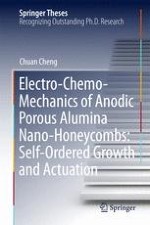2015 | Buch
Über dieses Buch
In this thesis, real-time evolution of the nanopore channel growth and self-ordering process in anodic nanoporous alumina are simulated on the basis of an established kinetics model. The simulation results were in accordance with the experiments on the (i) growth sustainability of pore channels guided by pre-patterns; and (ii) substrate grain orientation dependence on self-ordering. In addition, a new fabrication method for the rapid synthesis of highly self-ordered nanoporous alumina is established, based on a systematic search for the self-ordering conditions in experiments. Lastly, it reports on a novel surface-charge induced strain in nanoporous alumina-aluminium foils, which indicates that nanoporous alumina can be used as a new type of actuating material in micro-actuator applications.
Anzeige
